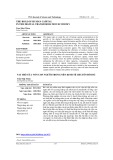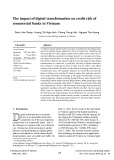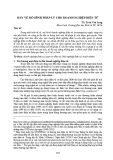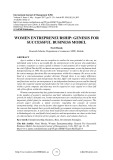
* Corresponding author
E-mail address: andres.munoz1@unisabana.edu.co (A. Muñoz-Villamizar)
© 2019 by the authors; licensee Growing Science.
doi: 10.5267/j.uscm.2019.3.002
Uncertain Supply Chain Management 7 (2019) 703–712
Contents lists available at GrowingScience
Uncertain Supply Chain Management
homepage: www.GrowingScience.com/uscm
Sustainability and digitalization in supply chains: A bibliometric analysis
Andrés Muñoz-Villamizara,c*, Elyn Solanoa, Carlos Quintero-Araujoa and Javier Santosb
aOperations and Supply Chain Management Research Group, Escuela Internacional de Ciencias Económicas y Administrativas, Universidad de La
Sabana, Chía, Colombia
bUniversidad de Navarra, TECNUN Escuela de Ingenieros, San Sebastián, Spain
cCenter for Transportation & Logistics, Massachusetts Institute of Technology, Cambridge, MA, USA
C H R O N I C L E A B S T R A C T
Article history:
Received February 1, 2019
Received in revised format March
1, 2019
Accepted March 21 2019
Available online
March 22 2019
Digitalization is impacting almost every aspect of people’s life and is greatly affecting supply
chain processes. At the same time, supply chains are becoming progressively more aware of
their impacts on people, the planet and profits (triple bottom line perspective) and the concept
of sustainable supply chain has received increasing attention among scholars and practitioners.
In this context, this article aims to analyze scientific research on supply chain management in
the field of sustainability and digitalization using a bibliometric approach. To this end, this
article analyses 484 papers from Scopus database according to the following parameters:
chronology, discipline, source, center, country and citations. The dataset consisted of articles
from scientific journals published over the period 2002–2018. In addition, VOSviewer
software is used to map the bibliographic material using the co-occurrence of keywords and
most influential journals. The analysis reveals that: sustainability and digitalization are
important emerging fields within supply chains that have increased significantly during the last
ten years; the USA is the most influential country; and the topic is structured around 2 clusters
(1) Supply chain management, concepts and practices and (2) energy related technologies. The
results may facilitate the planning, designing, running and publishing of future research on this
topic.
.Canada,
b
y the authors; licensee Growing Science2019 ©
Keywords:
Sustainability
Digitalization
Supply chain
Bibliometric analysis
Scopus
VOSviewer
1. Introduction
Supply chains can be defined as “the network of organizations that are involved, through upstream and
downstream linkages, in the different processes and activities that produce value in the form of products
and services in the hands of the ultimate consumer” (Mangan & Lalwanii, 2016, p.10). In the present
global environment, these organizational structures operate in complex and dynamic markets (Yang et
al., 2011) mainly affected by technological developments (Büyüközkan & Göçer, 2018). The
accelerated pace in digitalization of processes has transformed the business dynamic and market
structure (Kayikci, 2018; Waluyo, 2019), affecting supply chain management (Ward et al., 2017;
Büyüközkan & Göçer, 2018; Naway et al., 2019). The confluence of internet, wireless, predictive

704
analytics and cloud technologies (i.e., digitalization) have changed the entire supply chain operations
and has brought more value out of it (Yang et al., 2011).
At the same time, supply chain management is confronted by the constant growth of capital and
consumer goods in the global demand by persistently verifying overall interests for social,
environmental and economic aspects (Manavalan & Jayakrishna, 2019; Sabara et al., 2019). Therefore,
in addition to technological and digital parameters, social and environmental dimensions are considered
as important for supply chain performance (Dossou, 2018). As an example, digitalization has the
immense opportunity to reduce emissions from logistics as much as 10 to 12% by 2025 and to help
decarbonize the global economy (World Economic Forum, 2016). Consequently, the aim with the
digitalization of supply chains should be considered to a transformative change towards ‘sustainability’
(Kayikci, 2018).
The term ‘sustainability’ can be defined as expanding the corporate perspective to one that considers
environmental, social and economic aspects (i.e., triple bottom line) (Abdul-Rashid et al., 2017). This
concept, first introduced in 1987 (Brundtland, 1987), has been witnessed in the subsequent emergence
and adoption of environmental practices and standards, either in relation to production (life cycle
analysis, green building standards, etc.) or to management procedures (environmental management
system) in business and supply chains (Muñoz-Villamizar et al., 2018). Hence, beginning from the
1990s, new terms, such as reverse logistics, green logistics, and green supply chain, have appeared
(Hou et al., 2015). Therefore, the increasing focus on sustainable practices and information and
communications technology tools has led academia and industry to address sustainable and digital
supply chains in different ways (Papetti et al., 2019). For example, Sabat (2002) described how
emerging mobile wireless were unleashing the potential of the value chain in early 2002. Nunes et al.
(2006) discussed the opportunities for a supply chain optimization in the automotive industry using
Radio Frequency Identification (RFID) technology. Shrouf et al. (2014) discussed the role of the
Internet of Things in sustainable supply chains with the objective of achieving energy efficiency. Hazen
et al. (2016) studied the nature of big data analytics impact on supply chain sustainability. Kayikci
(2018) highlighted the benefits of the digitalization of logistics process and examined the sustainability
impact of digitalization in logistics. More recently, Manavalan and Jayakrishna (2019) presented a
literature review of Internet of Things, sustainable supply chains and Industry 4.0. Based on this
investigation, the authors prosed a framework for assessing the preparedness of supply chains for a
sustainable growth to meet industry 4.0.
Although the abovementioned literature review, as well as other works, provides valuable information
on the state of the literature on sustainable and digital supply chains, there is still much need for a
bibliometric approach for analyzing this literature (Amirbagheri et al., 2018). Bibliometric studies are
becoming very popular in the scientific literature, strongly motivated by access to bibliographic
information (Merigó et al., 2018). To the best of our knowledge, there are no studies that have analyzed
sustainable and digital supply chains research from a bibliometric analysis perspective. In that sense,
this paper aims to fulfill this gap in the literature.
The major contributions of the paper are highlighted as follows: 1) A detailed bibliometric analysis of
sustainability and digitalization in supply chains has been conducted using the most widely used
database (i.e., Scopus); 2) the research growth of sustainability and digitalization in supply chains is
documented from 2002 to 2018; 3) the most common parameters (e.g., highly productive authors, most
influential authors, most cited discipline, countries, and highly prolific institutions, etc.) are discussed;
4) the conceptualization of this topic over the years is presented using the most common keywords used
in the field; and 5) the main two research clusters for this topic are defined.
The rest of this paper is organized as follows. Section 2 describes the proposed research method.
Section 3 presents the analysis of the papers we identified from our bibliometric approach. Finally,

A. Muñoz-Villamizar et al. /Uncertain Supply Chain Management 7 (2019)
705
section 4 concludes the paper by presenting some concluding remarks in addition to guidelines for
future research.
2. Methodology
Bibliometrics is usually defined as a collection of research techniques that studies quantitatively the
bibliographic material (Pritchard 1969; Merigó et al., 2018; Pourkhani et al., 2019). These bibliometric
analyses are based on quantitative and reliable data (i.e., indexed publications). Therefore, the
bibliometric analysis is based on a stable foundation of knowledge and not (for example) on the hardly
verifiable opinions of expert groups (Zemigala, 2019). This method has been used in management
research to improve the understanding of theoretical structures in logistics and supply chain
management but also in various other fields (e.g., management information systems, operations
management, international management, etc.) (Bensalem & Kin, 2019).
From an academic point of view, it is important that the published material in a specific research field,
such as sustainability and digitalization in supply chains, could be classified so that researches and
practitioners can follow all the field's advances and trends (Gaviria-Marin et al., 2019). In recent years,
technological advances have also facilitated the development of bibliometric analysis, which has
become an increasingly popular technique among researchers (Ding et al., 2014).
The summary of the methodology for conducting the search is shown in Table 1. Our bibliometric
analysis is based on literature recorded in the Scopus citation database (www.scopus.com). The
decision to choose this database is based on the fact that “Scopus is the largest abstract and citation
database of peer-reviewed literature: scientific journals, books and conference proceedings.” (Elsevier,
2019). Scopus indexes many serial and non-serial publications and millions of conference papers,
including the majority of the most important journals in the field of operations management research
as listed in Barman et al. (2001), Olson (2005) and Theoharakis et al. (2007).
Table 1
Summary of used methodology
Unit of analysis Relevant books and articles whose main content focuses on the links between supply chains,
sustainability and digitalization
Type of analysis Qualitative and quantitative
Period of analysis 2002 – 2018
Search engines Scopus
Query string
Using the keywords that were associated with each of the concepts of this research, the
following query string was created:
TITLE-ABS-KEY ( ( "supply chain" OR "supply chains" OR scm OR "supply chain
management" ) AND ( sustainable OR sustainability ) AND ( digitalization OR smart OR
digital OR digitalisation OR digitization OR "Communication Technologies" OR "industry
4.0" ) ) AND ( EXCLUDE ( PUBYEAR , 2020 ) OR EXCLUDE ( PUBYEAR , 2019 ) )
Total number of articles
evaluated 484
In the first stage, the keywords ‘supply chain’ and ‘digitalization’ and ‘sustainability’ were entered in
the search tool of Scopus to obtain a first list of works combining these three terms in the title, abstract
or keywords. Using keywords of these early results, a new and complete search equation (i.e., query
string) was defined (see Table 1). The results were then filtered by subject area, keywords and year
using tools within Scopus. Text mining software called VOSviewer, developed by van Eck and
Waltman (2010) was also applied to detect nonrelevant repeating terms and exclude them from the list.
A continuous combination of text mining and Scopus filtering tools narrowed down the number of hits
until text mining no longer showed any irrelevant clusters of terms.

706
This generic search identified 484 publications published between 2002 and 2018. Although, the year
1987 can be defined as the starting point for the concept sustainability (Brundtland, 1987), it is
important to note that digitalization was enabled by the diffusion of Internet-based information and
communication technologies at the beginning of the years 2000 (Bicocchi et al., 2019). Consequently,
first publication on sustainability and digitalization in the supply chain is dated on 2002. Finally, results
from 2019 (and 2020) are excluded in the chart to avoid showing partial statistics (see Table 1). It is to
note that in the remainder of this article, the documents identified by Scopus are generally referred to
as papers and articles, even though some of them are book chapters.
3. Results
According to Noyons et al. (1999), bibliometrics combines two main procedures: performance analysis
and science mapping. Within performance analysis, there is descriptive bibliometrics (that is used for
trend analysis in scientific research based primarily on research centers, journals or regions); and
evaluative bibliometrics that is used to assess academic centers or researchers, based primarily on
citation indexes of articles (Zemigala, 2019). The study of these statistics allows one to grasp the trends
of the research field including the most influential authors and the most cited references (Bensalem &
Kin, 2019). On the other hand, science mapping is a spatial representation of how different scientific
actors are related to one another (Small, 1999). In this sense, this bibliometric component shows the
structural and dynamic aspects of scientific research using, for example: the co-occurrence of keywords
in documents, the co-citation analysis using pairs of documents that are commonly cited together, the
most important journals, etc. (Gaviria-Marin et al., 2019). This section presents both analysis with their
corresponding elements.
3.1. Annual citation and scientific disciplines
As mentioned before, the very first paper on sustainability and digitalization in supply chain
management was published in 1992. Since then, the number of published papers on this topic has
grown, especially in 2017. To better understand this trend, Table 2 reports the number of published
papers and their total citations. Additionally, Table 2 identifies the range of highly cited papers relative
to those with one or five citations.
Table 2
Annual citation
Years TP
100 50 20 10 51 TC
2002 1 0 00001 1
2003 3 0 00011 6
2004 9 0 00333 50
2005 8 0 00135 30
2006 3 1 11112 869
2007 10 1 23336 205
2008 10 0 01346 73
2009 2 1 11112 153
2010 16 0 0 0 1 3 12 43
2011 18 0 11246 79
2012 20 1 1 3 4 6 11 293
2013 27 1 223916 219
2014 32 2 3 5 7 8 17 446
2015 35 0 0 4 5 10 23 152
2016 38 0 2 5 9 14 26 306
2017 159 0 0 7 12 21 60 404
2018 93 0 0 3 5 12 44 238
Total 484 7 13 36 60 103 241 3567
% 100% 1% 3% 7% 12% 21% 50%
Ex
p
lanation. TP= Total
p
a
p
ers
;
≥100 ≥50
,
≥20
,
≥10
,
≥5
,
≥1 = Number of
p
a
p
ers with e
q
ual or more than 100
,
50
,
20
,
10
,
5 and 1
During the first 8 years of the time period studied in this paper, the number of published papers on
sustainability and digitalization in supply chains had not exceeded 10. After this period, there had been
a slight growth in the number of published papers on this topic, with a maximum of 38 papers in 2016.

A. Muñoz-Villamizar et al. /Uncertain Supply Chain Management 7 (2019)
707
However, in 2017, the number of published papers had a huge increase compared to previous years.
The amount of published research articles in 2017 was 159 (i.e., 33% of total sample). Regarding
citations, it should be noted that only 1% of the papers have received more than one hundred citations,
that are 7 out of 484 papers. In addition, 3% of the papers have received more than 50 citations and
7%, 12%, 21% and 50% of the papers have received more than twenty, ten, five and one citations,
respectively. It is also important to highlight that recently published articles (those published in the last
5 years) represent about 43% of total cites (1546 out of 3567 citations).
The next step is to analyze the most important scientific disciplines. In order to define areas of science
are focused on research on sustainability and digitalization in the supply chain, the taxonomy of
scientific areas considered by Scopus database was used. In the general set, articles have been assigned
to 14 different disciplines (see Table 3). Engineering clearly occupied the first place due to the nature
of the considered topics (i.e. sustainability, digitalization and supply chains). The scientific disciplines
from positions 1–4 were considered as leading and the rates in each of these areas were similar dozen
percent of the total general dataset. It is important to highlight that Energy discipline represents 15%
of the total sample. A thorough analysis of the results in section 3.3 allows a surmise that future research
in the Energy field is going to be a leading one. The disciplines from items 5–7 obtained interest rates
in the general set of half dozen or so percent. Positions 8-13 represent the less important disciplines.
The differences between these disciplines were not significant, as they reached similar percent. Finally,
unimportant disciplines as Physics and Astronomy, Biochemistry, Genetics and Molecular Biology,
Chemistry, etc., are groped in other categories, as they only represent 2.9% of total share.
Table 3
Research on sustainability and digitalization in the supply chain according to scientific disciplines
Rank Sub
j
ect area Pa
p
ers %
1. Leading, large, several dozen
percent share
En
g
ineerin
g
239 25.3%
Energy 142 15.0%
Computer Science 134 14.2%
Business, Management and Accounting 110 11.6%
2. Significant, medium, several
percent share
Environmental Science 71 7.5%
Decision Sciences 60 6.3%
Social Sciences 52 5.5%
3. Less important, small, at most
a few percent share
A
g
ricultural and Biolo
g
ical Sciences 24 2.5%
Materials Science 22 2.3%
Mathematics 20 2.1%
Economics, Econometrics and Finance 19 2.0%
Chemical Engineering 15 1.6%
Medicine 10 1.1%
4. Unim
p
ortant
,
minimal
,
at most Others 27 2.9%
3.2. Leading journals, authors, institutions and countries
Table 4 shows the top 14 journals. The journal with the largest number of articles is “IFIP Advances in
Information and Communication Technology” (TP=20 documents). However, the most important
journal that was focused on sustainability and digitalization in the supply chains was the “Journal of
Cleaner Production”, as it has the highest number of citations from the general dataset appeared there
(TC=446) and the highest average citation per document (C/D = 26.2). In addition, this title had the
highest impact factor SJR (Scimago Journal & Country Rank, 2019) among the reported sources. Other
journals with important average citations per document are “Supply Chain Management” and
“International Journal of Production Research”. Although “IFIP Advances in Information and
Communication Technology” and “Sustainability Switzerland” have more than 10 documents, their
SJR factor and average citation per document are quite low.

















![Đề kiểm tra Quản trị logistics [mới nhất]](https://cdn.tailieu.vn/images/document/thumbnail/2025/20251015/2221002303@sv.ufm.edu.vn/135x160/35151760580355.jpg)
![Bộ câu hỏi thi vấn đáp Quản trị Logistics [năm hiện tại]](https://cdn.tailieu.vn/images/document/thumbnail/2025/20251014/baopn2005@gmail.com/135x160/40361760495274.jpg)







